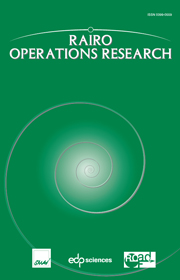No CrossRef data available.
Article contents
La différentiation automatiqueet son utilisation en optimisation
Published online by Cambridge University Press: 17 May 2008
Abstract
In this work, we present an introduction to automatic differentiation,its use in optimization software, and some new potential usages. Wefocus on the potential of this technique inoptimization. We do not dive deeply in the intricacies of automaticdifferentiation, but put forward its key ideas. We sketch a survey, asof today, of automatic differentiation software, but warn the readerthat the situation with respect to software evolves rapidly. In thelast part of the paper, we present some potential future usage ofautomatic differentiation, assuming an ideal tool is available, whichwill become true in some unspecified future.
Information
- Type
- Research Article
- Information
- Copyright
- © EDP Sciences, ROADEF, SMAI, 2008
References
Dussault, J.-P., High order Newton-penalty Algorithms.
J. Comput. Appl. Math.
182 (2005) 117–133.
CrossRef
J.-P. Dussault and B. Hamelin, Implementation of high order Newton Algorithms, in Scilab first international conference, Dec. 2004.
J.-P. Dussault and B. Hamelin, Robust descent in differentiable optimization using automatic finite differences. Optimization Methods and Software (2005). À paraître.
A. Griewank, On automatic differentiation, in Mathematical Programming: Recent Developments and Applications, edited by M. Iri and K. Tanabe, Kluwer Academic Publishers (1989) 83–108.
Griewank, A., Achieving logarithmic growth of temporal and spatial complexity in reverse automatic differentiation.
Optimization Methods and Software
1 (1992) 35–54.
CrossRef
A. Griewank, Evaluating Derivatives: Principles and Techniques of Algorithmic Differentiation. Frontiers in Appl. Math. 19 SIAM, Philadelphia, PA (2000).
J.J. Moré, Automatic differentiation tools in optimization software, in Automatic Differentiation of Algorithms: From Simulation to Optimization, Computer and Information Science, Springer, New York, NY (2001) Chapter 2, 25–34.

